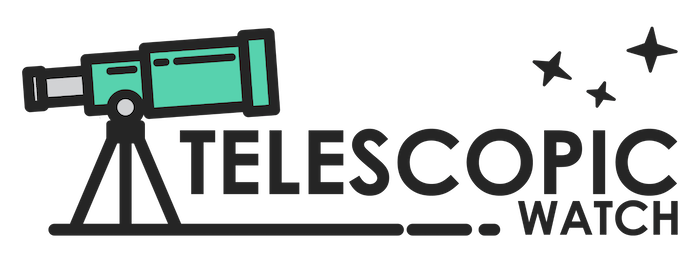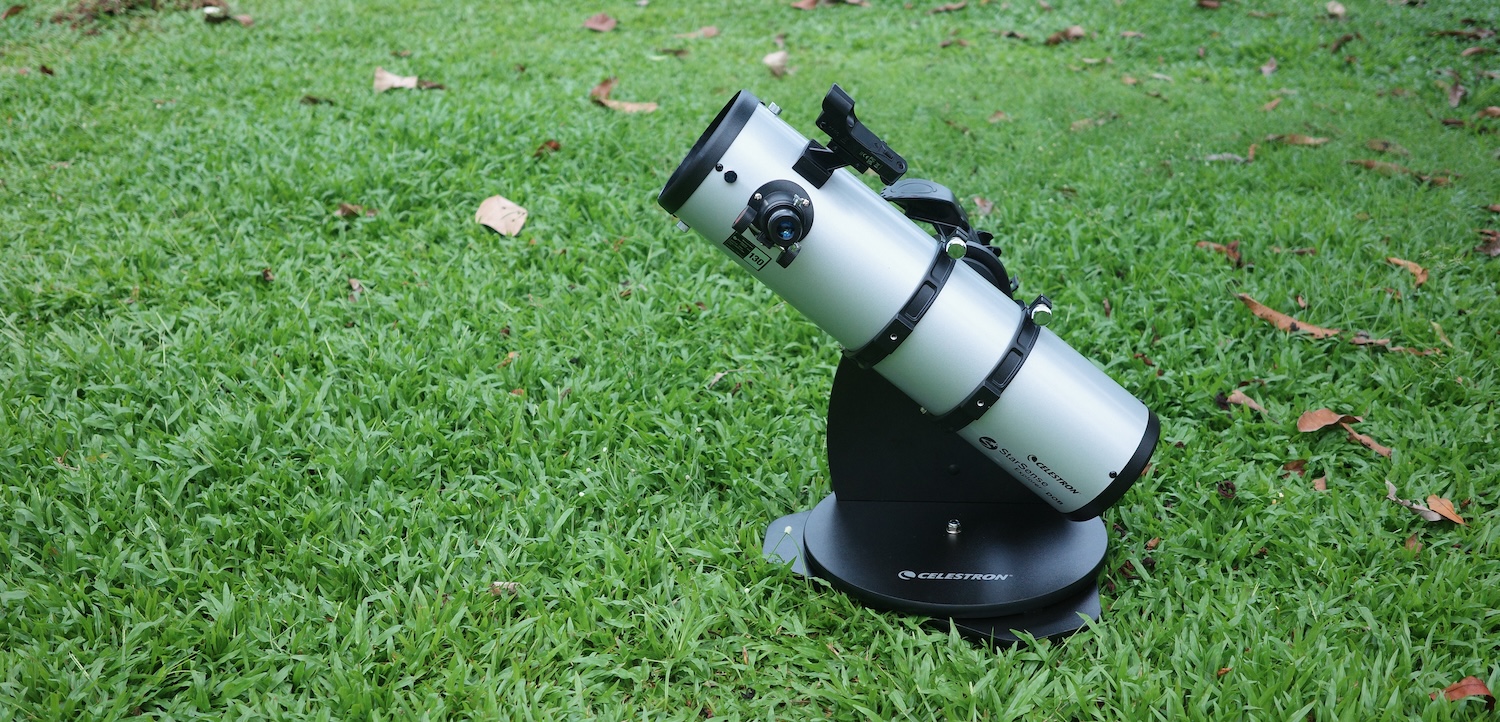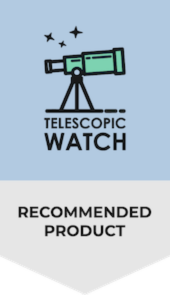The Optical Tube

The optical tube of the Celestron StarSense Explorer 130mm Dobsonian aligns with the design of most 130mm f/5 Newtonians I’ve seen on the market. These telescopes generally feature commendable parabolic primary mirrors, and I believe the 5.1″ aperture provides a solid starting point for serious explorations of the deep sky as well as lunar and planetary viewing.
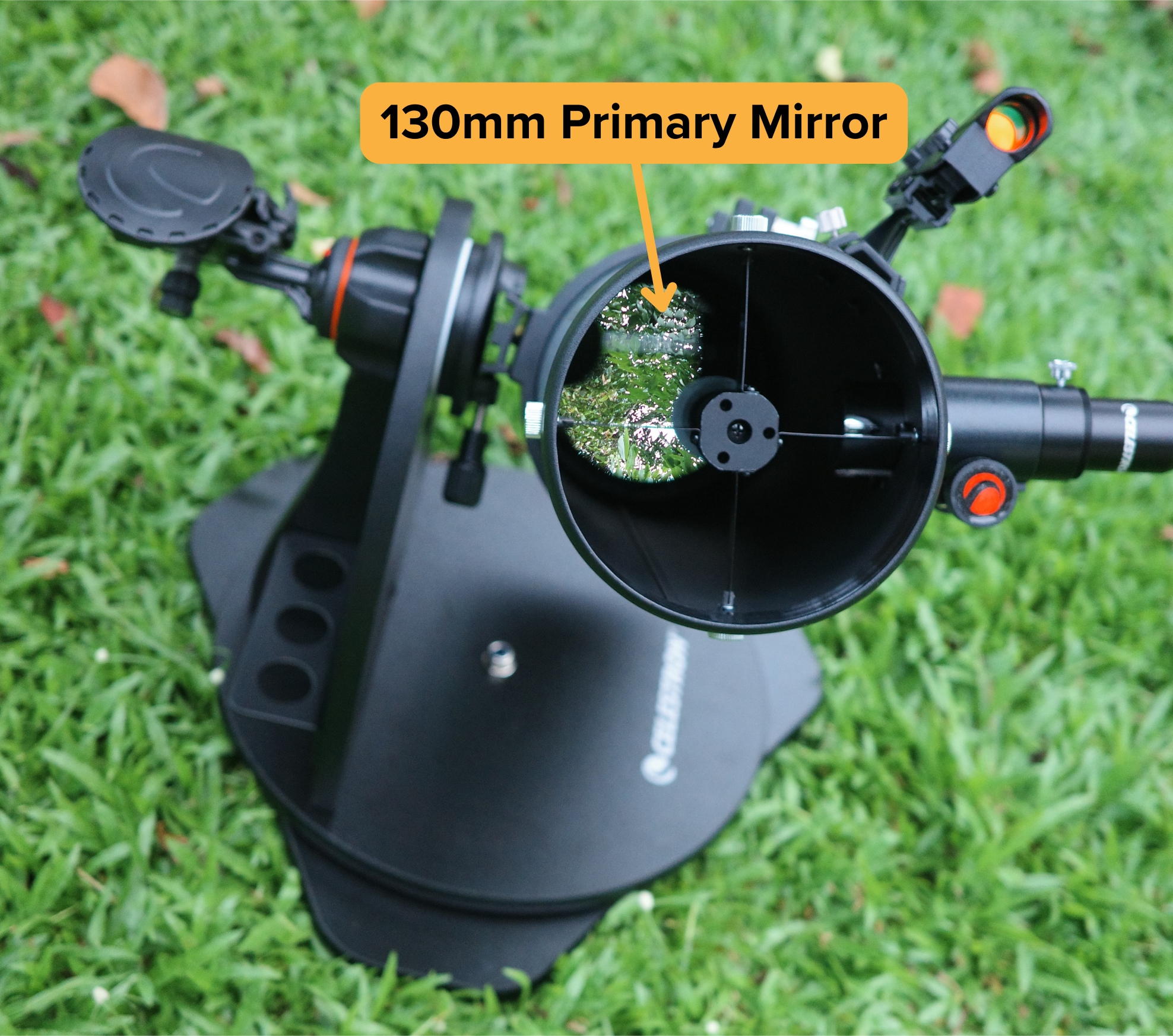
The f/5 focal ratio of the StarSense Explorer 130mm lends itself to an appreciably wide field of view of 2.1 degrees (equivalent to over four full moons across) with the bundled 25mm Kellner eyepiece. I could even extend it to over 2.5 degrees with a better aftermarket 1.25″ wide-field eyepiece, such as my 24 mm Explore Scientific 68°.
What I found curious is that the Celestron StarSense Explorer 130mm Dobsonian, for reasons not explicitly defined and unlike its 130mm DX cousin, opted for a simplified mirror cell, drawing inspiration from traditional Japanese-made reflectors. I can also recall that this mirror cell is identical to the cell I’ve seen in the Zhumell Z130.
The Rare But Annoying Collimation Requirements
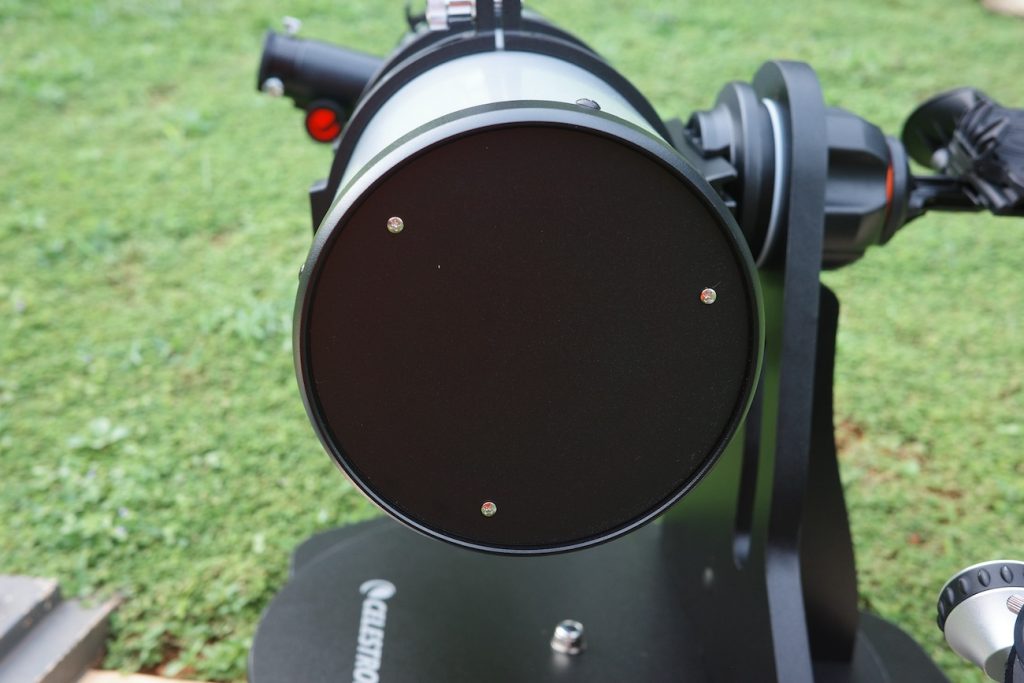
Collimating this reflector telescope necessitated me removing an unnecessary metal backplate with a screwdriver (it’s purely cosmetic; you can discard it). I then adjusted three pairs of push-pull screws, but be cautious—they can be easily stripped. I can also see that it can be difficult for someone to develop the finesse to fine-tune the screws accurately enough for good collimation.
That being said, the silver lining with this whole design is its remarkable collimation retention. I seldom ever needed to adjust the collimation. However, the downside is the requirement of tools and the possibility of stripping screws outdoors, potentially derailing our stargazing plans if there’s no late-night hardware store nearby.

For collimation purposes, with this telescope’s f/5 focal ratio, the included collimation cap is more than enough for me to accurately align this scope’s optics.
The Plastic 1.25″ Focuser
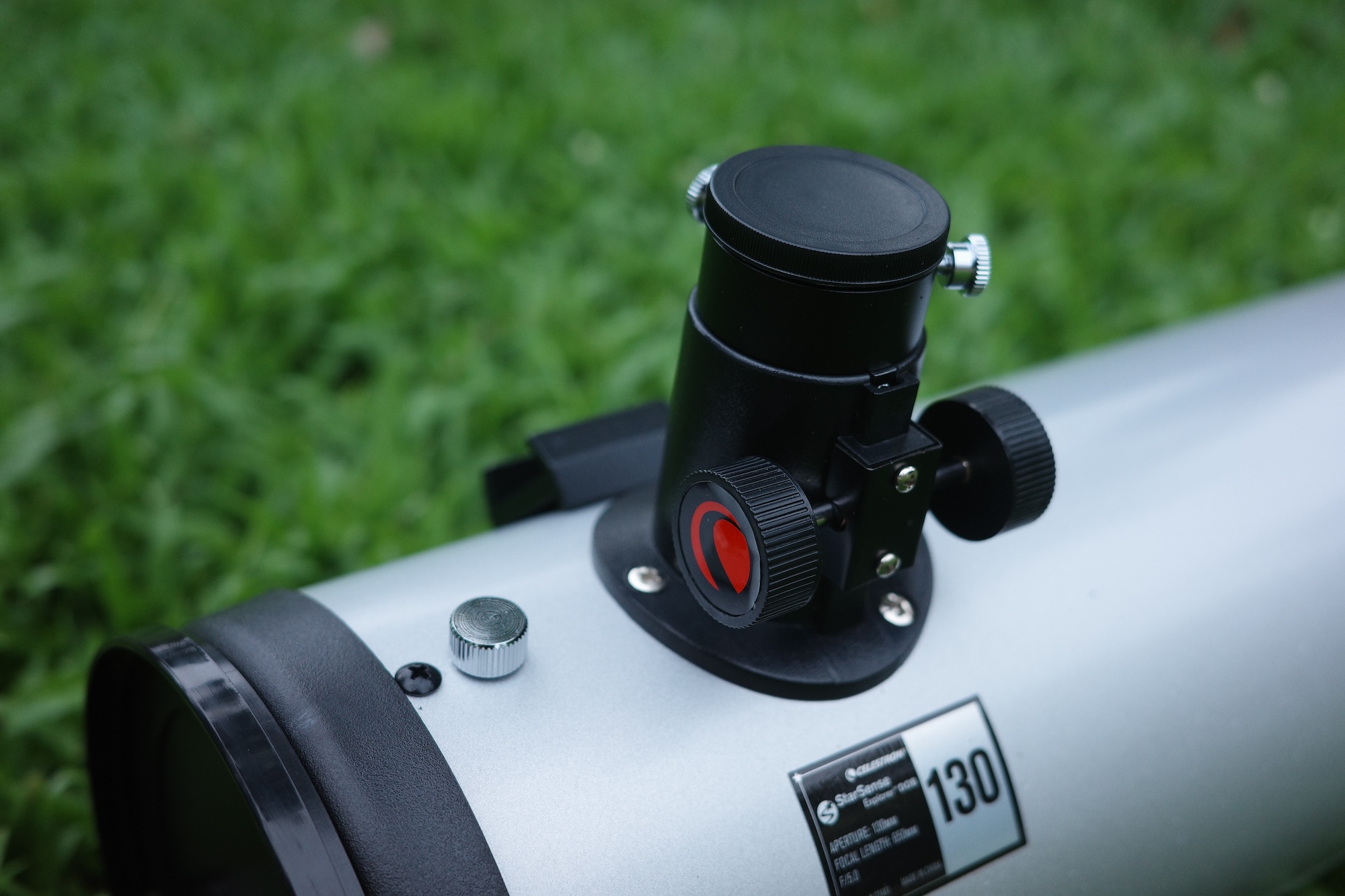
A 1.25″ plastic rack-and-pinion focuser is a common feature that I’ve seen in many beginner scopes, but at this price, it’s certainly a bottleneck. The cheap 1.25” rack-and-pinion unit employed on this scope wobbles and isn’t the most durable or precise that I’ve used in this price range and aperture.
Some other 130mm f/5s, like the StarSense Explorer DX 130mm, use a 2” focuser, offering a wider maximum field of view. The secondary mirror of these 130mm f/5 telescopes is actually plenty big to illuminate the field of a 2” eyepiece and coma corrector. It’s a shame that Celestron didn’t opt to use a 2” focuser with at least a partially metal construction.
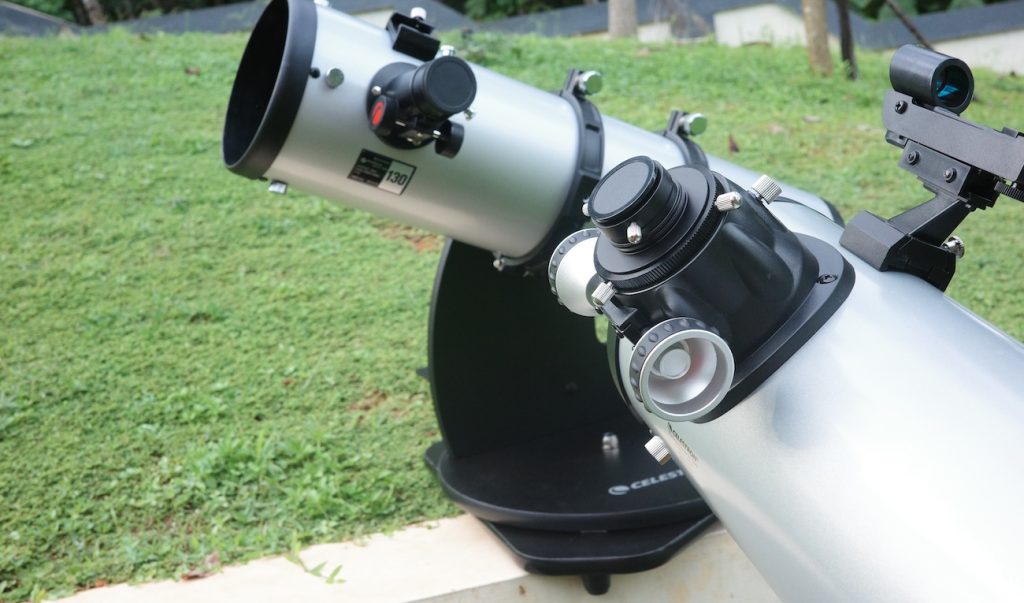
The Tube Rings Way of Attaching Mount to the Optical Tube
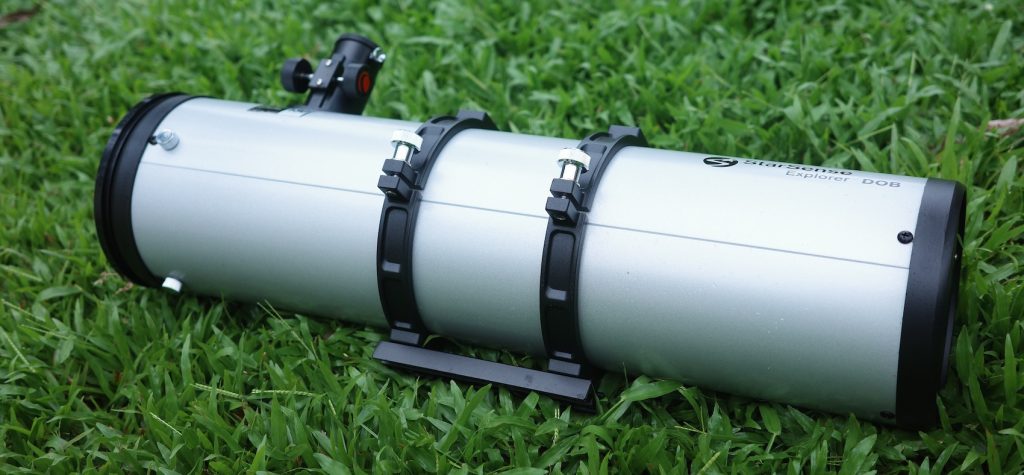
An unusual attribute (and another shared with the Zhumell Z130) adopted by the StarSense Explorer 130mm Dobsonian is the manner in which its optical tube is attached to the mount, utilising a pair of tube rings.
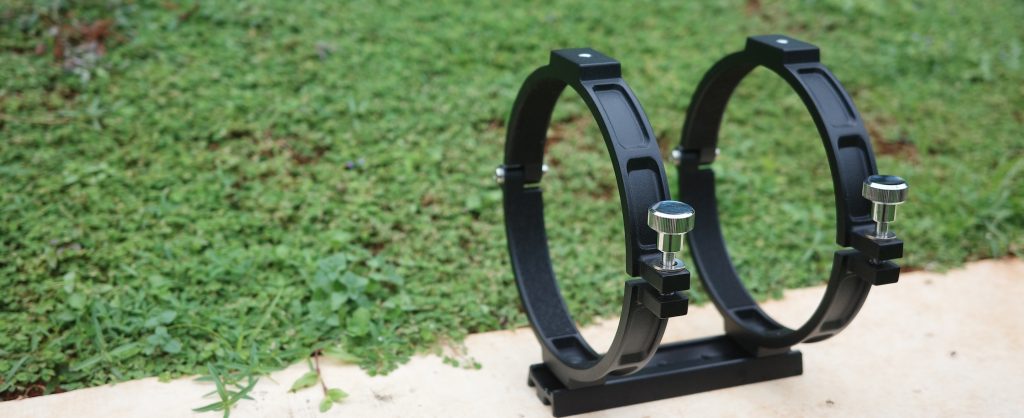
While this arrangement may seem excessive, it offers us the flexibility to rotate and slide the tube for optimal balancing and eyepiece positioning.
It also promises compatibility with nearly any other telescope mount without needing extra tools or hardware. It saves significant effort and expense if you ever decide to use your StarSense Explorer 130mm optical tube on an aftermarket equatorial or alt-azimuth mount and tripod.
Accessories
The Celestron StarSense Explorer 130mm Dobsonian came bundled with two Kellner eyepieces and a red dot finder. Specifically, it includes a 25mm (26x) and a 10mm (65x) eyepiece.
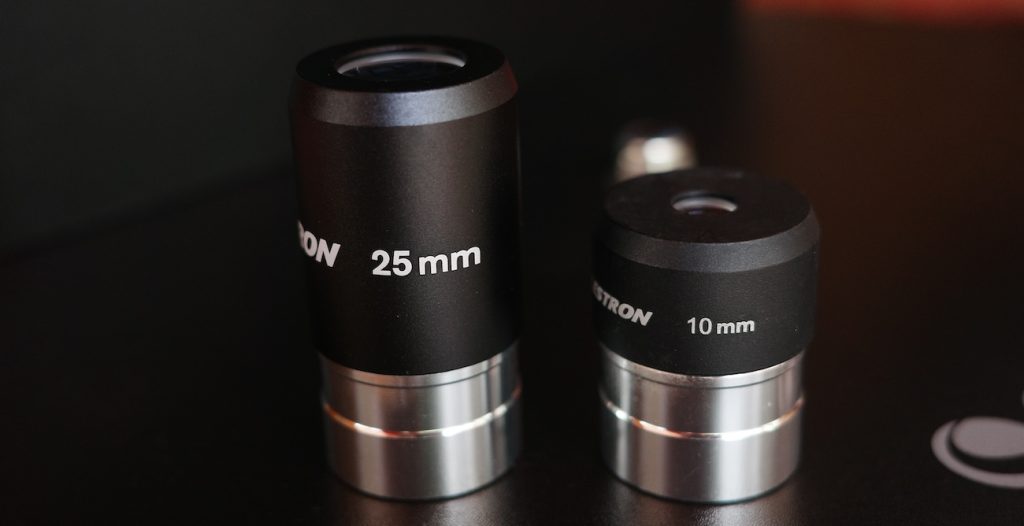
These eyepieces are metal in construction and feature coated glass optics, but no rubber eyecups. I could notice some edge-of-field chromatic aberration and glare with the eyepieces upon usage. And the 10mm, I felt, is rather short on eye relief. But they still do the job.
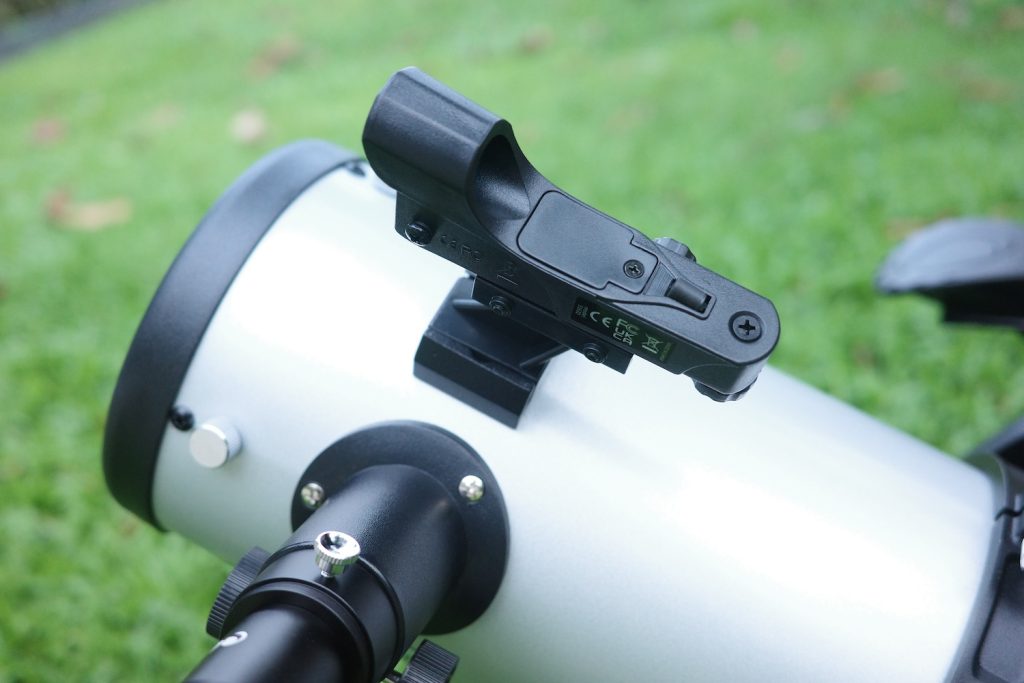
In my experience, the included red dot finder was more than adequate for aiming the scope whether I was using the StarSense Explorer phone dock or not.
Mount

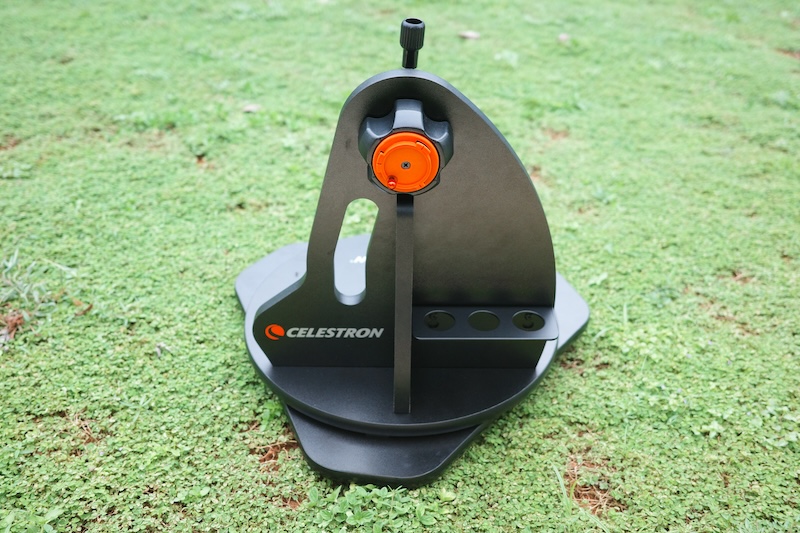
The Celestron StarSense Explorer 130mm Dobsonian is secured to its tabletop Dobsonian mount via its Vixen-style dovetail and rings, as seen below. When I’m using different-weight eyepieces/accessories with this scope, I can adjust the balance of the tube by sliding it within this pair of rings.

Tweaking the friction in the altitude direction of the mount is regulated by the large knob on the side affixed to the StarSense phone dock, as marked in the picture above. The azimuth adjustment requires us to obtain two wrenches or pliers to loosen or tighten the centre bolt and locknut shown in the picture below.
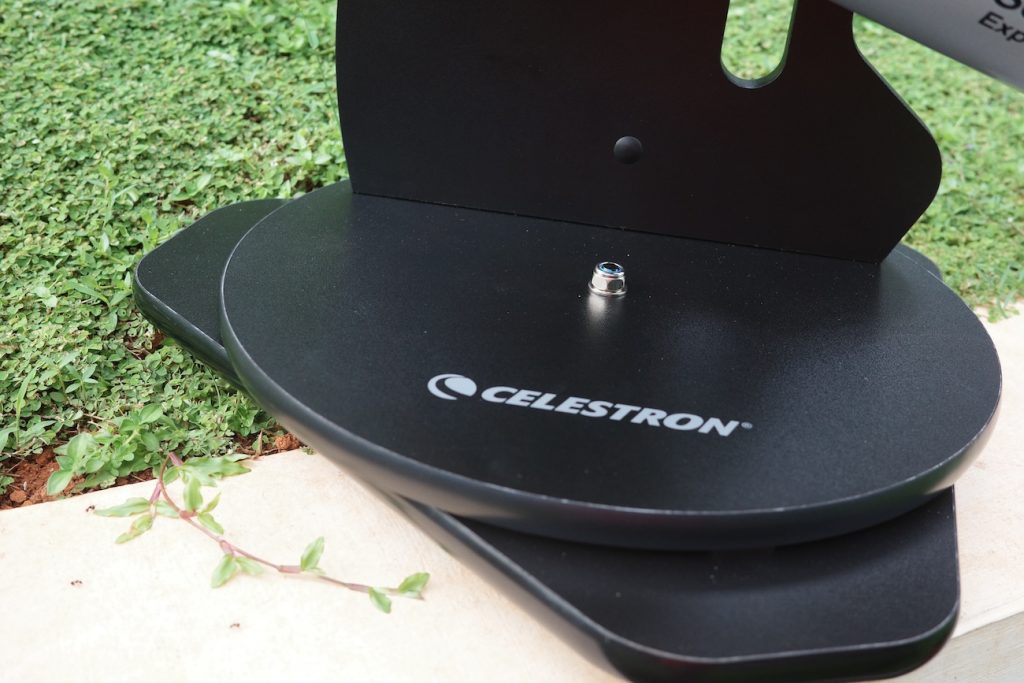
Apart from featuring an eyepiece rack that doesn’t accommodate many of my wider-bodied eyepieces, the mount of the StarSense Explorer 130mm includes cutouts designed as handles. For me, this handle alone contributed to the easier transportation of this somewhat hefty scope in a single piece.
How do I Place the Telescope While Observing?
The StarSense Explorer 130mm is promoted as a tabletop scope. However, I can see that finding tables that can stably hold it, particularly during high-magnification viewing or manual tracking, may prove challenging to you.
I won’t advise placing it on unstable surfaces such as a bar stool or a car hood. I’d instead recommend using a milk crate or creating a homemade wooden stand for more stable positioning.
Celestron does offer a tripod for use with this telescope, but it is extremely expensive for what you actually get, which further drives up the price of this already-pricey setup.
Celestron’s StarSense Explorer Technology
In essence, the Celestron StarSense Explorer 130mm tabletop Dobsonian utilises a form of technology that isn’t exactly new: plate-solving.
The plate-solving technique involves taking a snapshot of the night sky through a smartphone and then applying advanced computer algorithms alongside celestial maps to the photo taken to determine the telescope’s exact alignment. This methodology is traditionally used in astrophotography to sidestep the laborious task of GoTo alignment and is typically employed to locate a single astronomical object.
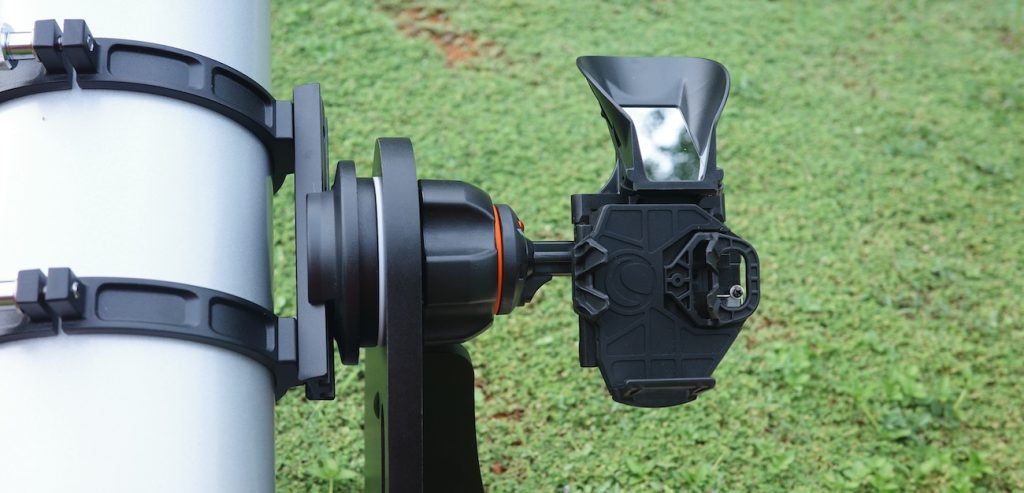
At its core, the technology behind the StarSense Explorer system essentially transforms our phone into an advanced guidance system for our telescope. The system involves aligning a small mirror with the telescope mount, then utilising the camera and computational capabilities of our smartphone to execute the process of plate-solving.
Setting up the phone dock that comes with the Celestron StarSense Explorer 130mm Dobsonian is quite a simple process, and operating the accompanying Celestron StarSense Explorer app is intuitive. After you go through a brief alignment procedure, the app assists you in locating thousands of deep-sky objects.
The application achieves this by continuously monitoring and displaying where our telescope is pointed in real-time, utilising the camera and gyroscope data from our smartphone. The level of precision achievable hinges on the quality of your smartphone. With my iPhone 14 Pro, it reaches an accuracy of around a quarter of a degree, roughly equivalent to half the width of a full moon.
I’ve noticed that Celestron has considerably upgraded the app for their Dobsonian range of telescopes, equipping it with a significantly larger database. This expanded database is a substantial improvement over the previous version, which limited the effectiveness of the StarSense Explorer technology to finding only the brightest and most conspicuous targets in the night sky.
Since the precision of the StarSense Explorer system peaks at just over 0.25 degrees, about half the width of a full moon, I don’t consider that it matches the exactness of a true GoTo system or encoder-based digital setting circles. Nevertheless, I can say for sure that it offers ample accuracy for identifying most deep-sky objects.
Should I buy a Used Celestron StarSense Explorer 130mm Dobsonian?
The Celestron StarSense Explorer 130mm tabletop Dobsonian stands as a splendid investment, especially if purchased second-hand.
Given the model’s recent launch, I guess it’d be rare to encounter one with degraded mirror coatings. However, bear in mind that buying a StarSense Explorer 130mm with damaged mirrors is not a cost-effective decision, as the expense of recoating usually exceeds that of a brand-new telescope.
You also need to be sure that the StarSense phone dock is still included. Celestron will generally provide additional unlock codes for the StarSense Explorer system if you ask them to, but I’ve personally seen multiple times that the hardware itself is removed from these telescopes for use with third-party setups.
Aftermarket Accessory Recommendations
You’ll find that the Celestron StarSense Explorer 130mm tabletop Dobsonian is capable of handling up to 200–250x magnification thanks to its 130mm aperture and sharp optics. However, the real-world benefits might start tapering off beyond 150–200x, as increasing the magnification further often leads to a hard-to-focus or dim view. Eyepieces such as the frequently recommended 6mm “redline” or “goldline” can offer 108x magnification with this telescope, while a specialised 4mm planetary eyepiece can provide up to 163x. The higher magnification levels are particularly useful for viewing planetary details, globular star clusters, and planetary nebulae and for splitting closely situated double or triple stars.
We would also recommend you replace the StarSense Explorer’s provided 10mm Kellner eyepiece with a 9mm redline or goldline ocular (72x), which offers a sharper, wider view with longer eye relief than the cheap Kellner design. Additional medium- and high-power oculars may be of some benefit, but you can select the focal lengths and make/model at your discretion for these.
A 27mm BST Flat-Field eyepiece (24x), a 24mm Celestron Ultima Edge (27x), or a 24mm Explore Scientific 68-degree eyepiece makes for an ideal low-power ocular for the StarSense Explorer 130mm Dobsonian, providing a field of view of 2.5 degrees, or about 5 times the angular diameter of the Moon in the sky. Any of these eyepieces is more immersive and displays sharper stars across the periphery of the field of view than the stock 25mm Kellner ocular.
A UHC, or Ultra-High Contrast, filter can significantly improve your views of emission nebulae with the StarSense Explorer 130mm by increasing their contrast against the background sky. While this does not substitute for the experience under truly dark skies, it can still augment the viewing even under dark conditions, as the natural sky background isn’t entirely dark anyway. A good nebula filter also helps to bring out tiny planetary nebulae at low magnification by preserving and highlighting their brightness while dimming surrounding star fields.
What can you see with the Celestron StarSense Explorer 130mm tabletop Dobsonian?
The Celestron StarSense Explorer 130mm tabletop Dobsonian telescope sits on the precipice of being capable of offering truly fascinating views of the moon, planets, and deep-sky objects, far beyond being just a beginner’s tool that you’d quickly outgrow.
With the StarSense Explorer 130mm, you’ll be able to discern globular clusters like M13 and M22, albeit minimally, and under truly dark skies, the spiral arms and dust lanes of bright galaxies like M51, M106, and M33 can become visible. Bear in mind that without genuinely dark skies where the Milky Way dominates overhead, these galaxies may seem like faint patches or become completely invisible.
Planetary nebulae, which generally appear as unexciting greyish smudges in smaller instruments, take on more character and detail with the StarSense Explorer 130mm, beginning to reveal various shades of blue and green and intricate fine detail on a steady night. The multitude of emission nebulae, such as Orion, along with countless brilliant open clusters and intriguing colourful double and variable stars, are sure to keep you occupied for a while, especially if you are fortunate enough to possess dark skies and/or a good UHC nebula filter.
Within our solar system, the StarSense Explorer 130mm effortlessly exhibits the phases of Venus and Mercury. Lunar details just a few kilometres across become visible. You could dedicate a lifetime to moongazing and continually discover something new, especially if you adjust your viewing times to catch the less frequently observed details during the waning phase past full.
Venturing further into our solar system, Mars and its polar ice caps are within the reach of the Celestron StarSense Explorer 130mm. Visible dust storms not only mask the other Martian details but also impart a beige-orange hue to the planet. During the period of opposition, prominent dark features on Mars, such as Syrtis Major, can be easily identified. For the seasoned observer with good timing, the Martian moon Deimos can be spotted by placing Mars and its glare outside the field of view.
The gas giant Jupiter is a spectacle to behold through the StarSense Explorer 130mm, with its cloud bands, swirls, festoons, and the iconic Great Red Spot visible on a calm, clear night. Jupiter’s moons transform from mere specks of light into distinct celestial bodies, their tiny discs becoming evident, particularly during their transit across the planet, casting shadows behind them.
Saturn, with its stunning ring system, is readily visible with the StarSense Explorer 130mm, including the gap within the rings known as the Cassini Division. You’ll also spot a number of Saturn’s moons and some cloud bands on the planet itself. Observing Uranus is fairly straightforward at high magnification, although its moons are too faint to discern. Neptune and its moon Triton present more of a challenge, with Triton barely within the StarSense Explorer 130mm’s capabilities—definitely worth a try, but success is not assured.
